
The Australian Defence Force (ADF) is the military organisation responsible for the defence of the Commonwealth of Australia and its national interests. It has three branches: the Royal Australian Navy (RAN), Australian Army and the Royal Australian Air Force (RAAF). The ADF has a strength of just over 89,000 personnel and is supported by the Department of Defence and several other civilian agencies.
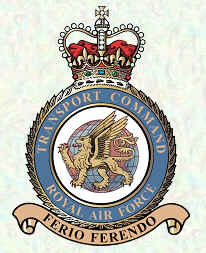
RAF Transport Command was a Royal Air Force command that controlled all transport aircraft of the RAF. It was established on 25 March 1943 by the renaming of the RAF Ferry Command, and was subsequently renamed RAF Air Support Command in 1967.

Leading aircraftman (LAC) or leading aircraftwoman (LACW) is a junior rank in some air forces. It sits between aircraftman and senior aircraftman, and has a NATO rank code of OR-2. The rank badge is a horizontal two-bladed propeller. The rank was renamed air specialist (AS2) in the Royal Air Force in July 2022.

RAAF Base Richmond is a Royal Australian Air Force (RAAF) military air base located within the City of Hawkesbury, approximately 50 kilometres (31 mi) North-West of the Sydney Central Business District in New South Wales, Australia. Situated between the towns of Windsor and Richmond, the base is the oldest base in New South Wales and the second oldest in Australia. The base is home to the transport headquarters RAAF Air Lift Group, and its major operational formations, Nos. 84 and 86 Wings. The main aircraft type operated at the base is the Lockheed C-130 Hercules. Richmond is a regular venue for air shows and had at times been mooted as a site for Sydney's proposed second international airport.
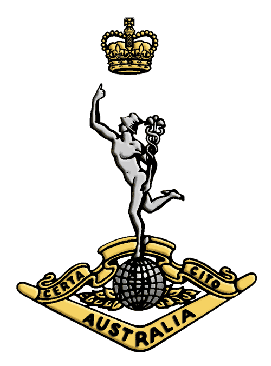
The Royal Australian Corps of Signals (RASigs) is one of the 'arms' of the Australian Army. It is responsible for installing, maintaining, and operating all types of telecommunications equipment and information systems. The motto of the Signals Corps is Certa Cito and is translated as 'Swift and Sure', signifying the aim of the signal service – that communication be carried out with maximum speed and certainty. Like their British counterparts, the Royal Australian Corps of Signals' flag and hat badge feature Mercury, the winged messenger of the gods, affectionately referred to by members of the corps as "Jimmy".
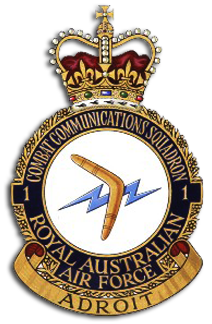
The Royal Australian Air Force's No. 1 Combat Communications Squadron (1CCS) is a squadron within No. 95 Wing and is responsible for the provision of expeditionary Communications and Information Systems (CIS) to support Air Force and Australian Defence Force operations and exercises.

No. 4 Squadron is a Royal Australian Air Force squadron composed of the air force special forces Combat Controllers, aircrew who operate the Pilatus PC-21 aircraft and instructors for the Australian Defence Force Joint Terminal Attack Controller (JTAC) course.

RAAF Williams is a Royal Australian Air Force (RAAF) military air base set across two locations, at Point Cook and Laverton, located approximately 20 km (12 mi) south-west of the Melbourne central business district in Victoria, Australia. Both establishments previously existed as separate RAAF Bases until 1989 when they were amalgamated to form RAAF Williams. The name was chosen in honour of Air Marshal Sir Richard Williams, the 'father' of the RAAF.
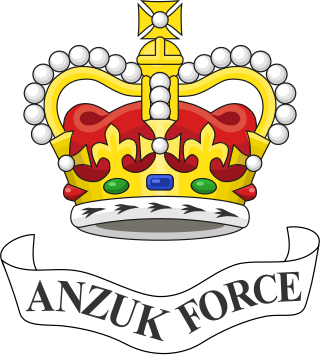
ANZUK was a tripartite force formed by Australia, New Zealand, and the United Kingdom to defend the Asian Pacific region after the United Kingdom withdrew forces from the east of Suez in the early 1970s. The ANZUK force was formed in Singapore on 1 November 1971 under Rear Admiral David Wells and disbanded on 31 January 1974.

No. 84 Wing is a Royal Australian Air Force (RAAF) transport wing. Coming under the control of Air Mobility Group (AMG), it is headquartered at RAAF Base Richmond, New South Wales. The wing comprises No. 35 Squadron, operating Aliena C-27J Spartan transport Aircraft; No. 37 Squadron, operating Lockheed Martin C-130J Super Hercules medium transports; and a technical training unit, No. 285 Squadron.
No. 26 Squadron RAAF is a Royal Australian Air Force Reserve squadron, headquartered at RAAF Base Williamtown in New South Wales, Australia. The squadron's role is to provide trained personnel to regular RAAF units during operations and on exercise.
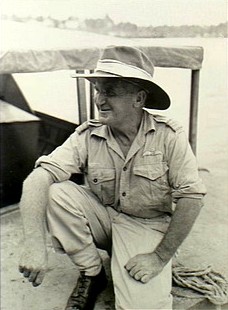
Alexander Augustus Norman Dudley "Jerry" Pentland, was an Australian fighter ace in World War I. Born in Maitland, New South Wales, he commenced service as a Lighthorseman with the Australian Imperial Force in 1915, and saw action at Gallipoli. He transferred to the Royal Flying Corps the following year, rising to captain. Credited with twenty-three aerial victories, Pentland became the fifth highest-scoring Australian ace of the war, after Robert Little, Stan Dallas, Harry Cobby and Roy King. He was awarded the Military Cross in January 1918 for "conspicuous gallantry and devotion to duty" on a mission attacking an aerodrome behind enemy lines, and the Distinguished Flying Cross that August for engaging four hostile aircraft single-handedly.
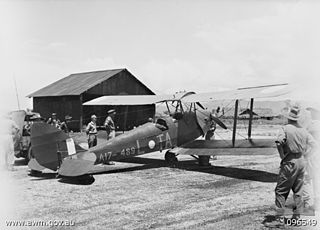
No. 10 Local Air Supply Unit was a Royal Australian Air Force air transport unit of World War II. No. 84 Wing was formed on 11 September 1944 in Cairns, Queensland. Commanded by Group Captain Bill Hely, it comprised No. 5 Squadron, No. 17 Air Observation Post (AOP) Flight, No. 10 Communication Unit, and No. 39 Operational Base Unit. The wing arrived at Torokina in October to begin supporting Australian troops during the Bougainville Campaign. 10 Communications Unit flew Avro Ansons and Bristol Beauforts on courier, reconnaissance, supply, and anti-malarial spraying missions; it was renamed No. 10 Local Air Supply Unit RAAF in March 1945. The Unit was also formed at Aitape, New Guinea on 18 April 1945 to undertake the local air supply of Australian Army units in New Guinea. The Unit here was equipped with a mix of Avro Anson, Bristol Beaufort and Tiger Moth aircraft and conducted supply and casualty evacuation flights until the end of the war. When the Pacific War ended in August 1945, No. 10 Local Air Supply Unit was tasked with dropping leaflets announcing the news over Japanese positions. Following the war No. 10 Local Air Supply Unit conducted courier flights to various locations in New Guinea until it was disbanded on 6 March 1946. 17 AOP Flight was disbanded on Bougainville in December, followed a month later by the Bougainville flight of No. 10 Local Air Supply Unit.

No. 9 Operational Group was a major Royal Australian Air Force (RAAF) formation providing fighter, ground-attack and anti-shipping support to the Allies in the South West Pacific theatre during World War II. Established in September 1942, it acted as a mobile striking force independent of the RAAF's static area commands. As the war in the Pacific progressed, No. 9 Operational Group itself developed into an area command called Northern Command, responsible for garrisoning New Guinea.

Mareeba Airfield is an airfield located 4.3 nautical miles south of Mareeba, Queensland, Australia. Built in 1942 as a US Army Air Force base during World War II, the airfield had two runways, with a complement of taxiways, hardstands and a containment area. After the war, much of the airfield reverted to agricultural use, while the southern runway remains as an active airfield.

No. 614 Squadron was originally formed on 1 June 1937 as an army co-operation squadron unit of the Auxiliary Air Force. It served during the Second World War first in this role and later as a bomber squadron. Upon reformation it served as a fighter squadron until the disbandment of the Royal Auxiliary Air Force on 10 March 1957.

No. 71 Wing was a Royal Australian Air Force (RAAF) wing of World War II. It was formed in February 1943 at Milne Bay, Papua New Guinea, as part of No. 9 Operational Group. The wing initially comprised two squadrons of P-40 Kittyhawks, one of Lockheed Hudsons, and one of Bristol Beauforts. The wing's mainstay soon became the Beaufort, which eventually equipped five squadrons attached to the formation. No. 71 Wing took part in the New Guinea campaign under the auspices of No. 9 Group, before transferring to No. 10 Operational Group for the Western New Guinea campaign during 1944. It then returned to the control of Northern Command to support Australian ground forces in the Aitape–Wewak campaign, and completed its final combat mission only hours before the Japanese surrender in August 1945. No. 71 Wing remained in New Guinea following the war and was disbanded in January 1946.

No. 1 Aircraft Depot (No. 1 AD) was a maintenance unit of the Royal Australian Air Force (RAAF). Formed in July 1921 at RAAF Point Cook, Victoria, it relocated to the nearby RAAF Laverton in March 1926. As well as servicing aircraft and other equipment, in its early years the depot supported survey flights in Australia and the Pacific region. It was also responsible for training maintenance staff.
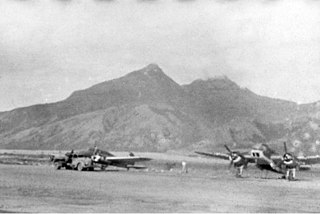
The Rescue and Communication Squadron was a Royal Australian Air Force (RAAF) squadron formed during World War II. Raised for service during the New Guinea campaign, the squadron existed between October 1942 and November 1943, and undertook a variety of support roles including search and rescue, transportation, reconnaissance and casualty evacuation. Upon disbandment, it was used to raise two new communications units.


















